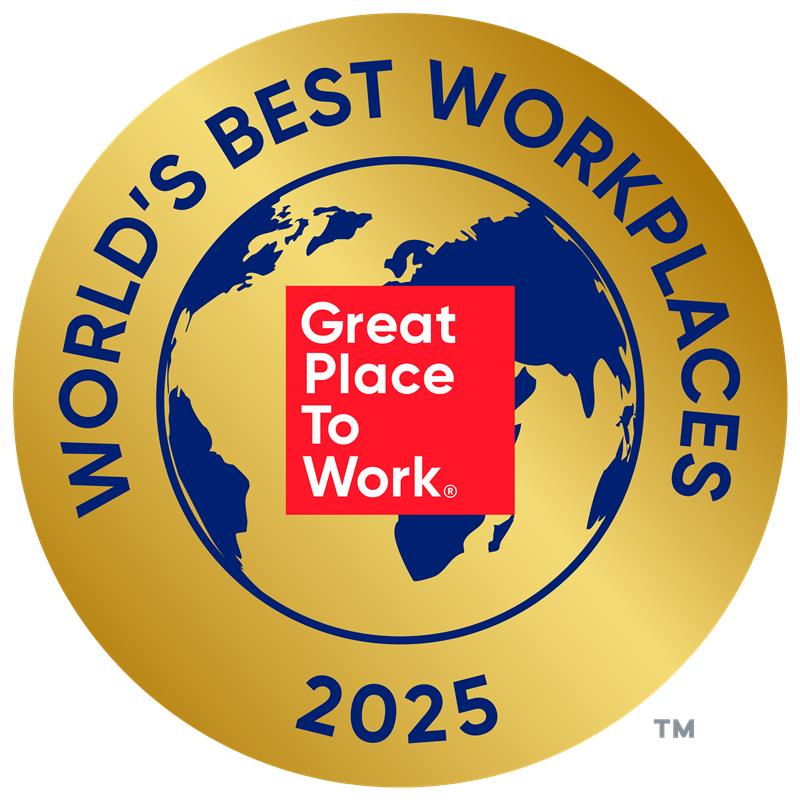
At Experian, we often say our people are our biggest superpower – and today, I’m thrilled to share that this belief has been recognised once again. Experian has been named one of the 2025 World’s Best Workplaces™ by Fortune and Great Place to Work® for the second year in a row.
This achievement reflects the culture we’ve built together – one that’s welcoming, inclusive, and rooted belonging. It’s a celebration of every colleague who brings their whole self to work, who lifts others up, and who powers opportunities for our clients, consumers, and communities.

We’ve made it our mission to create a workplace where everyone feels included, respected, and empowered. That’s why we’re proud to have earned top scores on the Corporate Equality Index and the Disability Equality Index, and to be recognised with the Outie Award for Workplace Excellence and Belonging.
These recognitions matter. But what matters most is how our people experience life at Experian. Whether it’s collaborating, innovating, or growing through world-class development of products, services and contributing to our communities, our culture is designed to help everyone thrive.
We’ve also made bold commitments to career development. Initiatives like Global Careers Week, the AI-driven performance coach Nadia, and the NextGen Forum – a global leadership development programme for emerging talent from across our regions – give our people the resources to take charge of their growth and build a “One Experian” mindset.
Being named one of the World’s Best Workplaces is a moment to celebrate but also a reminder to keep aiming higher. The world of work is evolving fast, and so are we. From embracing AI to enhancing our digital workplace experience, we’ll continue to push forward and listen to our people every step of the way.
Questions we will discuss:
- What does “retirement readiness” mean to you, and how can someone tell when they are financially ready to retire?
- Is there a magic number for retirement savings, and what factors should someone consider when setting a retirement goal?
- How can someone estimate their retirement expenses realistically?
- What are some common myths or misconceptions about how much money you need to retire?
- How should Gen Z, Millennials, and Gen Xers each approach retirement planning differently based on their stage of life?
- What are the biggest obstacles people face when trying to save for retirement, and how can they overcome them?
- How can you balance saving for retirement with paying off debt or supporting family today?
- What tools, calculators, or strategies can help people figure out if they’re on track for retirement?
- How can people prepare for unexpected costs or life changes that could impact their retirement plans?
- What’s one piece of advice you’d give someone just starting—or restarting—their retirement savings journey?
| Columns 1 | Column 2 | Column 3 | Column 4 |
|---|---|---|---|
| Row 1 Col 1 | |||
| Row 2 Col 1 | |||
| Row 3 Col 1 | |||
| Footer 1 | Footer 2 | Footer 3 | Footer 4 |

Credit Chat
Stretching your Dollars: Practical Tips to Cut Costs and Save More
February 5, 2025 3-4 PM ET
- What does “retirement readiness” mean to you, and how can someone tell when they are financially ready to retire?
- Is there a magic number for retirement savings, and what factors should someone consider when setting a retirement goal?
- How can someone estimate their retirement expenses realistically?

Greater transparency in buy now, pay later activity is key to helping consumers build their credit histories and supporting responsible lending. We have members of the military right now right out of high school and there’s not a lot of experience managing their own money. They’re quickly thrust into a place where they don’t have a support system to do that. We have members of the military right now right out of high school and there’s not a lot of experience managing their own money. They’re quickly thrust into a place where they don’t have a support system to do that. We have members of the military right now right out of high school and there’s not a lot of experience managing their own money. They’re quickly thrust into a place where they don’t have a support system to do that. We have members of the military right now right out of high school and there’s not a lot of experience managing their own money. They’re quickly thrust into a place where they don’t have a support system to do that. We have members of the military right now right out of high school and there’s not a lot of experience managing their own money. They’re quickly thrust into a place where they don’t have a support system to do that.
Experian North AmericaScott Brown, Group President, Financial Services

Good data is a critical part of building a robust business strategy. Organizations use actionable data insight to improve the customer experience, drive operational efficiencies, leverage cost savings, and enhance the bottom line. In fact, the majority of sales decisions are expected to be driven by customer data by 2020. This is not surprising, given the volume and variety of data available to us today. We are spending so much to store and manage this information, we might as well use it to our advantage. Businesses are focused on using the power of analytics and the information they have before them to better serve customers and optimize business processes. However, a new Experian Data Quality study shows that the majority of organizations are not in possession of the high quality data needed for these decisions, which has been the case for the past several years. About a quarter of information is believed to be inaccurate and that poor quality data is affecting many aspects of operations and the customer experience. The main reason for this high level of inaccuracy is poor data management practices. Data management is often fragmented and driven by multiple stakeholders rather than by a single data specialist. This creates inconsistencies in the data and reactive processes for correcting inaccuracies. The good news is this legacy mindset is starting to change. We are seeing more organizations advance their data management strategies to include a central data owner and a number of data management projects planned over the next year, especially around data integrations, data cleansing, and data migrations. The biggest problem organizations face around data management today actually comes from within. Businesses get in their own way by refusing to create a culture around data and not prioritizing the proper funding and staffing for data management. Many businesses know they need to improve their data quality, but often have a hard time defining why an investment is needed in the current structure. Organizations need to invest in the people, processes, and technology around data management to improve this valuable asset and leverage it to improve their organizational performance. To learn more about global trends in data management, download The 2016 global data management benchmark report.

New findings from the 2015 holidays season were released by Experian Marketing Services a recognized leader in data-driven marketing and cloud-based marketing technology, showing a significant increase in email volume year-over-year. The report, Holiday Hot Sheet: Insights for the Holiday Marketer, indicates that email volume rose 24.8 percent during the 2015 holiday season compared to 2014, across all-industry verticals. Despite the increase in volume, the number of email opens, clicks and transactions also increased. Unique email opens increased 19 percent, unique email clicks increased 10 percent and email transactions increased 20 percent. “As retailers find more ways to incorporate data to create more personalized and relevant emails, we are seeing both volume and transactions increase,” said Spencer Kollas, vice president of global deliverability services at Experian Marketing Services. “The 2015 holiday season showed us once again that marketers are still finding email to be a valuable way to increase sales.” The report highlights other key marketing trends that defined the 2015 holiday season including the popularity of free shipping and an increase in emails opened on mobile devices. Ninety percent of retail email campaigns included an offer According to Experian’s analysis, 90 percent of retail email campaigns during the 2015 holiday season included an offer, free shipping was the most common, followed by percent off. The percent-off email offers featuring coupons or codes increased from 34 percent to 40 percent in 2015, allowing more tracking of responses. Mobile shopping continues to increase The report found that the percent of email clicks received on a mobile device from retailers during the peak of the holiday season increased 7 percent from 2014. In addition, SMS messaging continued to be an emphasis. 88 percent of text messages included an offer with 55 percent of text messages including some percent off. Cyber Monday retained its rank as the top email volume and transaction day Although Thanksgiving Day unseated Cyber Monday as the top online shopping day, Experian Marketing Services research shows that Cyber Monday retained its rank as the top email volume and transaction date. The top three email transaction dates in 2015 included: Cyber Monday Black Friday Sunday after Black Friday The top three email volume dates in 2015 included: Cyber Monday Black Friday Day before Thanksgiving

2,500 university students across 16 cities have been trained by Experian's experts and young volunteers of the social responsibility project ‘Manage Your Future Now’ project. The project, which was launched by Experian to promote self-improvement among university students, female entrepreneurs, and SMEs, reached the milestone in December and the achievement was celebrated at a recent event at the Experian office in Turkey. Coming from 10 cities across the country, 42 participants gathered to share their experiences. Feedback was positive with everyone agreeing that the project has been beneficial in increasing awareness of social responsibility. The participants were presented with a certificate for their commitment and contribution to the project. ‘Manage Your Future Now’ is a partnership between Experian, the United Nations Development Program and the Habitat Association/Center and Credit Bureau. The initiative includes providing training on financial risks, responsible borrowing, financial management and the efficient management of relationships with banks and the financial sector. Didem Köprücü, Human Resources Manager for Turkey and the Middle East at Experian, said: “We are proud that more people are benefiting under the ‘Manage Your Future Now’ project. Our training is improving every year and I would like to thank all the volunteers and young trainers for their valuable contribution. “The third stage of our project in 2016 will cover financial risk management, as well as financial opportunities for entrepreneur candidates. For this stage of the project we plan to reach 3,000 students and entrepreneur candidates across 26 cities. “However, we intend to continue our project, reaching more people every year.” The project aims to reach 3,000 students by the end of March 2016.
2024 Best Place to Work for Disability Inclusion


